A significant part of the heat loss in a private house is due to an insulated roof with a cold attic. Therefore, for owners seeking to optimize heating costs, it is important to warm the attic under the roof. To do this, you need to choose the material for insulation, taking into account the design features of the roof. Laying the insulation is easy to do on your own. This work does not require any special knowledge or skills.
Content
The method of performing insulation
To reduce heat loss in a private house, work is carried out for its thermal insulation. One of the stages is the insulation of the ceiling, since it is through the overlap that there is a significant degree of heat loss in the room. To insulate the attic in a private house, you need to choose the right materials and choose the best way to do the job.
There are two possible options for carrying out the work:
- carry out all actions from the living room;
- insulate the ceiling in a cold attic.
The first option, according to professional builders, can not be called optimal. After such insulation, you will definitely have to build forced ventilation. For this method, only expensive and high-tech materials are suitable. Installation of insulation from the side of the apartment is technically difficult to carry out.
Performing work from the attic is technically more competent and makes it possible to use different heaters. Placing materials in the attic is much easier. The disadvantage of this method is its dependence on weather conditions.
How to choose a heater
To insulate the ceiling in the house, you need to choose high-quality material. When buying, take into account the following indicators:
- resistance to thermal influence;
- ability to pass air;
- ability to absorb moisture;
- degree of fire;
- volumetric mass;
- resistance to sunlight;
- health safety;
- durability;
- price;
- possibility of self-assembly.
The materials used for insulation from the living room and from the attic side differ in their performance. For thermal insulation of the ceiling use:
- slabs or mats of various stiffness made of stone or basalt fiber;
- expanded or extruded polystyrene foam;
- polyurethane foam boards;
- linen insulation.
To better insulate the attic of a private house, choose the following materials:
- any of the existing mineral wool insulation;
- linen mats or plates;
- polystyrene foam plates of various types;
- liquid polyurethane or plates from it;
- bulk insulation of gas silicate, expanded clay or perlite;
- liquid spraying agents;
- natural environmental substances.
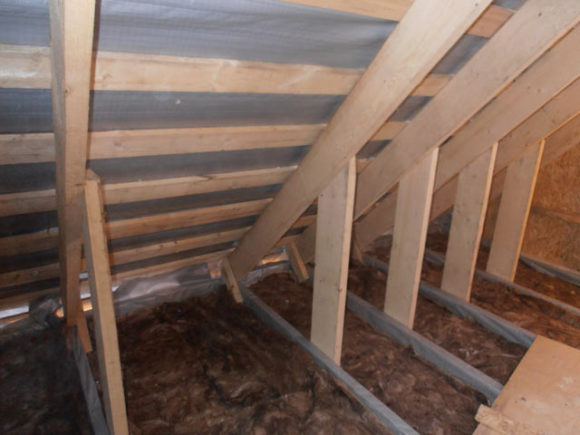
Mineral fiber insulation
Such materials effectively retain heat and allow air to pass through. They are not exposed to burning and destruction from sunlight, serve for a long time. The disadvantage of such a heater is that it loses heat-insulating qualities from exposure to moisture. Therefore, when installing such a material, a vapor barrier is arranged from below, and protect it with waterproofing from above.
The cheapest insulation from this series is slag. It is produced on the basis of smelting waste.Therefore, it sometimes contains residual radiation. Before buying, it is recommended that you check this material with a dosimeter at the store.
It also effectively retains the heat of glass wool. But it forms a thin, sharp dust, which is dangerous for the respiratory system and skin. Therefore, it is not recommended to warm a residential building with it.

Flax insulation
This TIM is based on flaxseed waste. By its heat-insulating properties, it is not inferior to mineral wool. The main advantage of such insulation is that even after exposure to moisture, this material continues to function effectively. The lack of flax material in its high cost.
Expanded polystyrene
Expanded polystyrene thermal insulation is on sale of different types. She copes well with her direct task, but has a significant drawback - rodents often settle in her. Therefore, when using such material, you need to take care of additional protection. Polystyrene foam does not light up from the fire, but emits toxic smoke. To protect against it during the installation of thermal insulation indoors, it is necessary to use a non-combustible lining.
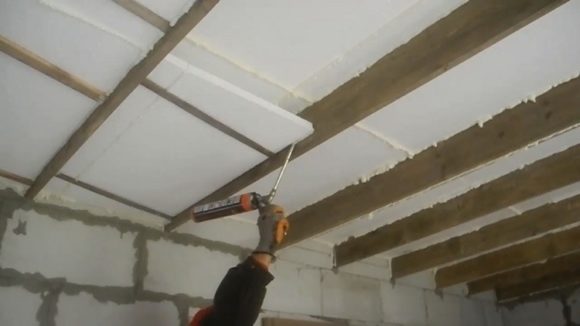
Polyurethane foam
Such material is recognized by builders as the most effective for maintaining heat. It is environmentally friendly, not destroyed by moisture, rodents do not eat it. The lack of polyurethane foam at a significant cost. Also, to make such thermal insulation, you need special equipment for application.
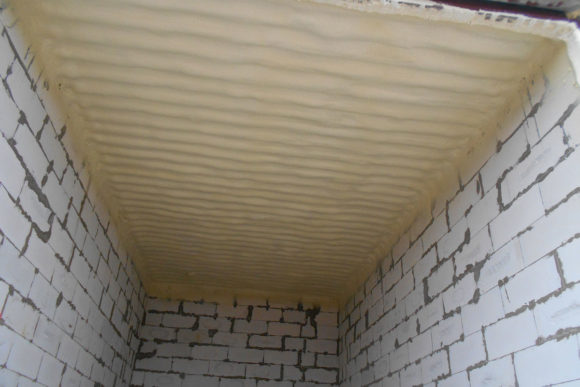
Bulk insulation
Known expanded clay, vermiculite, or gas silicate belong to this group of thermal insulation. They are inexpensive and sold in any hardware store. The disadvantage of such thermal insulation is the ability to absorb moisture, a large mass and not a good enough result.
To make high-quality thermal insulation in a house located in a temperate climate, in the attic you need to lay a layer of expanded clay 40 cm or more thick. In this case, no less than 200 kg will fall per square meter. Such a mass without additional reinforcement can only withstand a reinforced concrete slab. If the floors are made of wood, they will have to be strengthened.
Liquid insulation
Such material is ecowool. It is often used to insulate the roof. To reduce flammability and make it safer, flame retardants are introduced into ecowool. The disadvantage of liquid insulation is the need to rent special equipment.
Natural insulation
The main advantage of straw, clay, sawdust and other natural heaters in their low cost. Often, such material can generally be taken for free. Another advantage in environmental friendliness. They do not harm humans or animals. In all other respects, the use of natural insulation is not effective. To maintain good heat, you need to lay a thick layer of material. Over time, it begins to rot, attracts the attention of rodents. It has to be processed with special compounds so that mice do not eat. Therefore, such thermal insulation can only be used as a last resort.
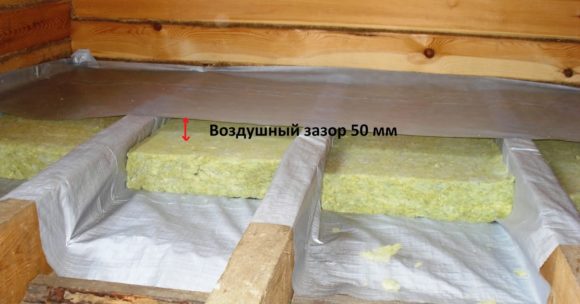
Ceiling insulation from below
If you decide to insulate the ceiling in a private house with your own hands from the living room, you can make a multilayer structure with a wooden crate on the ceiling. To do this, a membrane for waterproofing is attached to the ceiling with wooden strips passing at right angles to the guide beams of the ceiling. As a result, cells are formed in which the plates of the selected insulation are laid on the glue. Then the vapor barrier is attached with a special double-sided tape. In the final, the insulation is covered with drywall, wall paneling or other suitable material.
To insulate the ceiling from a reinforced concrete slab, anchors are staggered at it at an interval of 30 cm. The selected insulation is wrapped in vapor barrier and the edges are fixed with breathable adhesive tape. Prepared insulation boards are fixed on anchors and bent.Then, a wire for plastering is tied to the anchors with wire. At the end, the ceiling is plastered.
Instead of plastering, you can finish the ceiling with drywall. To do this, not guides are attached to the anchors, but guides.
Attic insulation
To begin with, the attic is prepared for construction work. To do this, the room is freed from foreign objects and trash. Then the wooden structures are treated with a composition that prevents rot and protects against infection by fungus. All metal structural parts are coated with an anti-corrosion primer. The old insulation is removed, they also come with rags, rags and sawdust. All cracks found during cleaning are covered with foam.
Then, in a clean room, a membrane for vapor barrier is laid on the roll and logs. The canvases are lapped and fastened with double-sided vapor-permeable tape for reliability.
Then heat insulation is mounted on top. The mineral wool mats are laid end to end so that there are no gaps between them and the beams and ceilings. In the same way, the material is placed in rolls.
From above, the laid thermal insulation is covered with another layer of the vapor barrier membrane and the sheets are fastened with adhesive tape.
Then the floor beams are closed with a wooden board or other suitable material. When the attic is used as a living room, leveling logs are laid and a rough plank floor is laid.
First, waterproofing is laid on the concrete floor, and then thermal insulation. It is closed with another waterproofing layer. From above, the entire structure is poured with a screed.
At the end of all work, utilities are insulated in the attic. For this, the pipes are wrapped with mineral wool. A layer of roofing material is laid on top of it. The whole structure is fastened with wire.
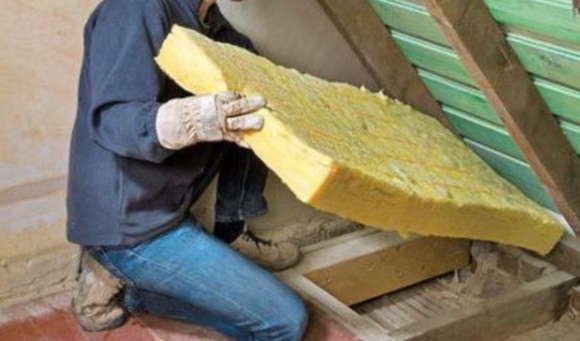
Conclusion
The choice of insulation method depends only on the excellent preferences and financial capabilities of the owner of a private house. But if possible, you need to choose effective materials that will not harm the health of households and animals and will reliably hold the accumulated heat indoors.

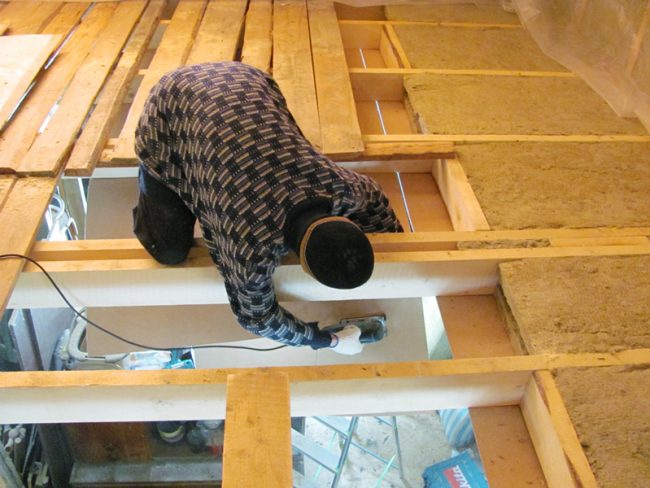



Alas, no comments yet. Be the first!